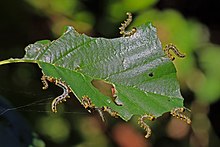
Back عديمات الخصر Arabic عديمة الخصر ARZ Symphyta AST Oturaqqarıncıqlılar Azerbaijani Símfits Catalan Širopasí Czech Savhvepse Danish Pflanzenwespen German Symphyta Esperanto Symphyta Spanish
| Sawfly Temporal range:
| |
|---|---|

| |
| Tenthredo mesomela | |
| Scientific classification | |
| Domain: | Eukaryota |
| Kingdom: | Animalia |
| Phylum: | Arthropoda |
| Class: | Insecta |
| Order: | Hymenoptera |
| Suborder: | Symphyta Gerstaecker, 1867[1] |
| Superfamilies[2] | |

Sawflies are wasp-like insects that are in the suborder Symphyta within the order Hymenoptera, alongside ants, bees, and wasps. The common name comes from the saw-like appearance of the ovipositor, which the females use to cut into the plants where they lay their eggs. The name is associated especially with the Tenthredinoidea, by far the largest superfamily in the suborder, with about 7,000 known species; in the entire suborder, there are 8,000 described species in more than 800 genera. Symphyta is paraphyletic, consisting of several basal groups within the order Hymenoptera, each one rooted inside the previous group, ending with the Apocrita which are not sawflies.
The primary distinction between sawflies and the Apocrita – the ants, bees, and wasps – is that the adults lack a "wasp waist", and instead have a broad connection between the abdomen and the thorax. Some sawflies are Batesian mimics of wasps and bees, and the ovipositor can be mistaken for a stinger. Sawflies vary in length, most measuring 2.5 to 20 millimetres (3⁄32 to 25⁄32 inch); the largest known sawfly measured 55 mm (2+1⁄4 in). The larvae are caterpillar-like, but can be distinguished by the number of prolegs and the absence of crochets in sawfly larvae. The great majority of sawflies are plant-eating, though the members of the superfamily Orussoidea are parasitic.
Predators include birds, insects and small animals. The larvae of some species have anti-predator adaptations such as regurgitating irritating liquid and clustering together for safety in numbers. Sawflies are hosts to many parasitoids, most of which are Hymenoptera, the rest being Diptera.
Adult sawflies are short-lived, with a life expectancy of 7–9 days, though the larval stage can last from months to years, depending on the species. Parthenogenetic females, which do not need to mate to produce fertilised eggs, are common in the suborder, though many species have males. The adults feed on pollen, nectar, honeydew, sap, other insects, including hemolymph of the larvae hosts; they have mouth pieces adapted to these types of feeding.[3]
Sawflies go through a complete metamorphosis with four distinct life stages – egg, larva, pupa and adult. The female uses her ovipositor to drill into plant material (or, in the case of Orussoidea, other insects) and then lays eggs in groups called rafts or pods. After hatching, larvae feed on plants, often in groups. As they approach adulthood, the larvae seek a protected spot to pupate, typically in bark or the soil. Large populations of species such as the pine sawfly can cause substantial damage to economic forestry, while others such as the iris sawfly are major pests in horticulture. Outbreaks of sawfly larvae can defoliate trees and may cause dieback, stunting or death. Sawflies can be controlled through the use of insecticides, natural predators and parasitoids, or mechanical methods.
Sawflies first appeared 250 million years ago in the Triassic. The oldest superfamily, the Xyeloidea, has existed into the presents. Over 200 million years ago, a lineage of sawflies evolved a parasitoid lifestyle, with carnivorous larvae that ate the eggs or larvae of other insects. Sawflies are distributed globally, though they are more diverse in the northernmost hemispheres.
- ^ Gerstaecker, C.E.A. (1867). "Ueber die Gattung Oxybelus Latr. und die bei Berlin vorkommenden Arten derselben". Zeitschrift für die Gesammten Naturwissenschaften (in German). 30 (7): 1–144.
- ^ Aguiar, A.P.; Deans, A.R.; Engel, M.S.; Forshage, M.; Huber, J.T.; Jennings, J.T.; Johnson, N.F.; Lelej, A.S.; Longino, J.T.; Lohrmann, V.; Mikó, I.; Ohl, M.; Rasmussen, C.; Taeger, A.; Yu, D.S.K. (2013). "Order Hymenoptera In: Zhang, Z.-Q. (ed.) Animal biodiversity: an outline of higher-level classification and survey of taxonomic richness". Zootaxa. 3703 (1): 51–62. doi:10.11646/zootaxa.3703.1.12. PMID 26146682.
- ^ Jervis, Mark; Vilhelmsen, Lars (2000). "Mouthpart evolution in adults of the basal, 'symphytan', hymenopteran lineages". Biological Journal of the Linnean Society. 70: 121–146. doi:10.1111/j.1095-8312.2000.tb00204.x.
© MMXXIII Rich X Search. We shall prevail. All rights reserved. Rich X Search